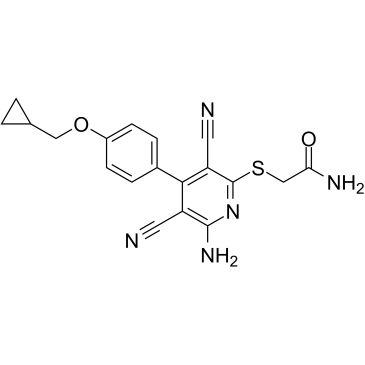| Description |
BAY 60-6583 is a potent and high-affinity agonist of adenosine A2B receptor (EC50 = 3 nM) over A1, A2A, and A3 receptors. BAY 60-6583 binds to mouse, rabbit, and dog A2BAR with Ki values of 750 nM, 340 nM and 330 nM, respectively. BAY 60-6583 has a cardioprotective effect in a myocardial ischemia model[1][5].
|
| Related Catalog |
|
| In Vitro |
BAY 60-6583 exhibits EC50 values for receptor activation >10,000 nM for both A1 and A2A AR and 3 nM for A2B AR subtype in CHO cells expressing recombinant human A1, A2A or A2B ARs[1]. BAY 60-6583(0-10 µM) exhibits the maximum agonist effect of BAY in the absence of siRNA is 68 %, which is significantly different from that in the presence of 5, 50 and 500 nM siRNA (54%, 48% and 36%, respectively). It exhibits EC50 values of BAY in the absence and presence siRNA with 98±22, 102±17, 127±31 and 93±19 nM, respectively, in T24 cells[3]. BAY 60-6583 (5 μM; 24 hours) increases the accumulation of cells at the G1 phase with a decrease in G2/M phase in RAW264.7 preosteoclasts[4]. BAY 60-6583 (5 μM; 24 hours) specifically inhibits the activation of Akt by M-CSF, whereas M-CSF-induced ERK1/2 activation is not affected by BAY 60-6583 treatment in RAW264.7 preosteoclasts[4]. Cell Cycle Analysis[4] Cell Line: RAW264.7 preosteoclasts Concentration: 5 μM Incubation Time: 48 hours Result: Caused an arrest of cells at the G1 phase. Western Blot Analysis[4] Cell Line: RAW264.7 preosteoclasts Concentration: 5 μM Incubation Time: 48 hours Result: Exhibited an inhibition of M-CSF-mediated Akt activation and resulted in the decrease of osteoclast proliferation.
|
| In Vivo |
BAY 60-6583 (intravenous injection; 100 mcg/kg) reduces the infarction area just prior to reperfusion in ischaemic rabbit hearts[1]. BAY 60-6583 (intraperitoneal injection; 2 mg/kg) attenuates LPS-induced lung injury, pre-treatment with this compound can significantly decrease LPS-increased IL-6 levels in WT-mice, In contrast, BAY 60-6583 treatment is ineffective in abrogating these inflammatory parameters in A2BAR−/− mice[2]. BAY 60-6583 (intratumoral administration) causes a significant increase in tumor-infiltrating MDSCs, it does not affect neither their ability to suppress T-cell proliferation nor their degree of maturation, it also stimulates the production of IL-10 and CCL2 in the tumor tissue[5]. Animal Model: A2BAR−/− mice on a C57BL/6J mice[1] Dosage: 2 mg/kg Administration: Intraperitoneal injection; 2 mg/kg Result: Demonstrated attenuation of lung inflammation and pulmonary edema in wild-type but not in gene-targeted mice for the A2BAR.
|
| References |
[1]. Aherne CM, et al. Epithelial-specific A2B adenosine receptor signaling protects the colonic epithelial barrier during acute colitis.Mucosal Immunol. 2015 Nov;8(6):1324-38. [2]. Schingnitz U, et al. Signaling through the A2B adenosine receptor dampens endotoxin-induced acute lung injury.J Immunol. 2010 May 1;184(9):5271-9. [3]. Gao ZG, et al. Probing biased/partial agonism at the G protein-coupled A(2B) adenosine receptor.Biochem Pharmacol. 2014 Aug 1;90(3):297-306. [4]. Yoon Taek Oh, et al. A2B Adenosine Receptor Stimulation Down-regulates M-CSF-mediated Osteoclast Proliferation. Biomed Sci Letters 2017;23:194-200 [5]. John A. Auchampach, et al. Characterization of the A2B Adenosine Receptor from Mouse, Rabbit, and Dog. J Pharmacol Exp Ther. 2009 Apr;329(1):2-13. [6]. Morello S1, et al. Targeting the adenosine A2b receptor in the tumor microenvironment overcomes local immunosuppression by myeloid-derived suppressor cells.Oncoimmunology. 2014 Feb 14;3:e27989. eCollection 2014.
|


